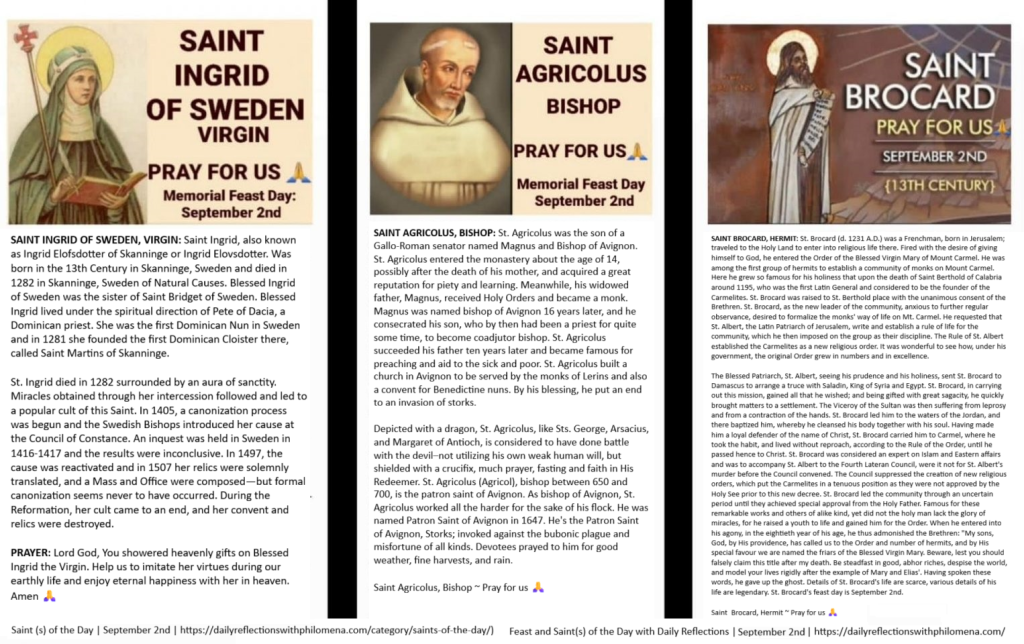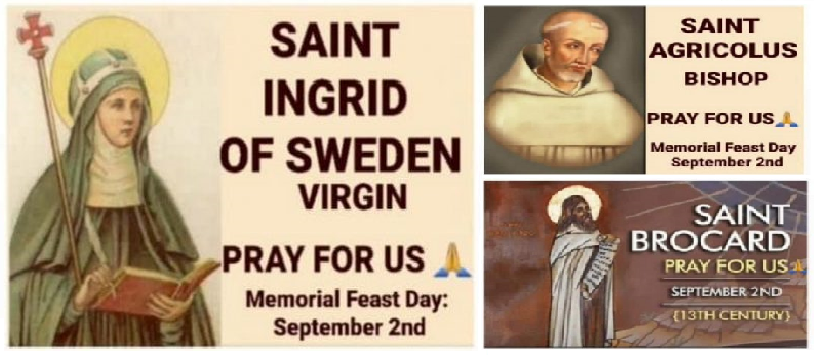
MEMORIAL OF SAINT INGRID OF SWEDEN, VIRGIN AND SAINT AGRICOLUS, BISHOP, SAINT BROCARD, HERMIT ~ FEAST DAY: SEPTEMBER 2ND: Today, we celebrate the Memorial of Saint Ingrid of Sweden, Virgin; Saint Agricolus, Bishop and Saint Brocard, Hermit. Through the intercession of our Blessed Mother Mary and the Saints on this feast day, we humbly pray for the sick and dying, especially those suffering from cancers and other terminal diseases. We pray for the repose of the souls of the faithful departed, for all widows and widowers, and all those who mourn. We pray for the safety and well-being of the poor and needy and for peace, love, and unity in our marriages, our families, and our world. And we continue to pray for our Holy Father, the Bishops, the Clergy, for vocations to the priesthood and religious life, for the Church, for persecuted Christians, for the conversion of sinners, and Christians all over the world.🙏
SAINT INGRID OF SWEDEN, VIRGIN: Saint Ingrid, also known as Ingrid Elofsdotter of Skanninge or Ingrid Elovsdotter. Was born in the 13th Century in Skanninge, Sweden and died in 1282 in Skanninge, Sweden of Natural Causes. Blessed Ingrid of Sweden was the sister of Saint Bridget of Sweden. Blessed Ingrid lived under the spiritual direction of Pete of Dacia, a Dominican priest. She was the first Dominican Nun in Sweden and in 1281 she founded the first Dominican Cloister there, called Saint Martins of Skanninge.
St. Ingrid died in 1282 surrounded by an aura of sanctity. Miracles obtained through her intercession followed and led to a popular cult of this Saint. In 1405, a canonization process was begun and the Swedish Bishops introduced her cause at the Council of Constance. An inquest was held in Sweden in 1416-1417 and the results were inconclusive. In 1497, the cause was reactivated and in 1507 her relics were solemnly translated, and a Mass and Office were composed—but formal canonization seems never to have occurred. During the Reformation, her cult came to an end, and her convent and relics were destroyed.
PRAYER: Lord God, You showered heavenly gifts on Blessed Ingrid the Virgin. Help us to imitate her virtues during our earthly life and enjoy eternal happiness with her in heaven. Amen 🙏
SAINT AGRICOLUS, BISHOP: St. Agricolus was the son of a Gallo-Roman senator named Magnus and Bishop of Avignon. St. Agricolus entered the monastery about the age of 14, possibly after the death of his mother, and acquired a great reputation for piety and learning. Meanwhile, his widowed father, Magnus, received Holy Orders and became a monk. Magnus was named bishop of Avignon 16 years later, and he consecrated his son, who by then had been a priest for quite some time, to become coadjutor bishop. St. Agricolus succeeded his father ten years later and became famous for preaching and aid to the sick and poor. St. Agricolus built a church in Avignon to be served by the monks of Lerins and also a convent for Benedictine nuns. By his blessing, he put an end to an invasion of storks.
Depicted with a dragon, St. Agricolus, like Sts. George, Arsacius, and Margaret of Antioch, is considered to have done battle with the devil–not utilizing his own weak human will, but shielded with a crucifix, much prayer, fasting and faith in His Redeemer. St. Agricolus (Agricol), bishop between 650 and 700, is the patron saint of Avignon. As bishop of Avignon, St. Agricolus worked all the harder for the sake of his flock. He was named Patron Saint of Avignon in 1647. He’s the Patron Saint of Avignon, Storks; invoked against the bubonic plague and misfortune of all kinds. Devotees prayed to him for good weather, fine harvests, and rain.
Saint Agricolus, Bishop ~ Pray for us 🙏
SAINT BROCARD, HERMIT: St. Brocard (d. 1231 A.D.) was a Frenchman, born in Jerusalem; traveled to the Holy Land to enter into religious life there. Fired with the desire of giving himself to God, he entered the Order of the Blessed Virgin Mary of Mount Carmel. He was among the first group of hermits to establish a community of monks on Mount Carmel. Here he grew so famous for his holiness that upon the death of Saint Berthold of Calabria around 1195, who was the first Latin General and considered to be the founder of the Carmelites. St. Brocard was raised to St. Berthold place with the unanimous consent of the Brethren. St. Brocard, as the new leader of the community, anxious to further regular observance, desired to formalize the monks’ way of life on Mt. Carmel. He requested that St. Albert, the Latin Patriarch of Jerusalem, write and establish a rule of life for the community, which he then imposed on the group as their discipline. The Rule of St. Albert established the Carmelites as a new religious order. It was wonderful to see how, under his government, the original Order grew in numbers and in excellence.
The Blessed Patriarch, St. Albert, seeing his prudence and his holiness, sent St. Brocard to Damascus to arrange a truce with Saladin, King of Syria and Egypt. St. Brocard, in carrying out this mission, gained all that he wished; and being gifted with great sagacity, he quickly brought matters to a settlement. The Viceroy of the Sultan was then suffering from leprosy and from a contraction of the hands. St. Brocard led him to the waters of the Jordan, and there baptized him, whereby he cleansed his body together with his soul. Having made him a loyal defender of the name of Christ, St. Brocard carried him to Carmel, where he took the habit, and lived without reproach, according to the Rule of the Order, until he passed hence to Christ. St. Brocard was considered an expert on Islam and Eastern affairs and was to accompany St. Albert to the Fourth Lateran Council, were it not for St. Albert’s murder before the Council convened. The Council suppressed the creation of new religious orders, which put the Carmelites in a tenuous position as they were not approved by the Holy See prior to this new decree. St. Brocard led the community through an uncertain period until they achieved special approval from the Holy Father. Famous for these remarkable works and others of alike kind, yet did not the holy man lack the glory of miracles, for he raised a youth to life and gained him for the Order. When he entered into his agony, in the eightieth year of his age, he thus admonished the Brethren: “My sons, God, by His providence, has called us to the Order and number of hermits, and by His special favour we are named the friars of the Blessed Virgin Mary. Beware, lest you should falsely claim this title after my death. Be steadfast in good, abhor riches, despise the world, and model your lives rigidly after the example of Mary and Elias’. Having spoken these words, he gave up the ghost. Details of St. Brocard’s life are scarce, various details of his life are legendary. St. Brocard’s feast day is September 2nd.
Saint Brocard, Hermit ~ Pray for us 🙏
